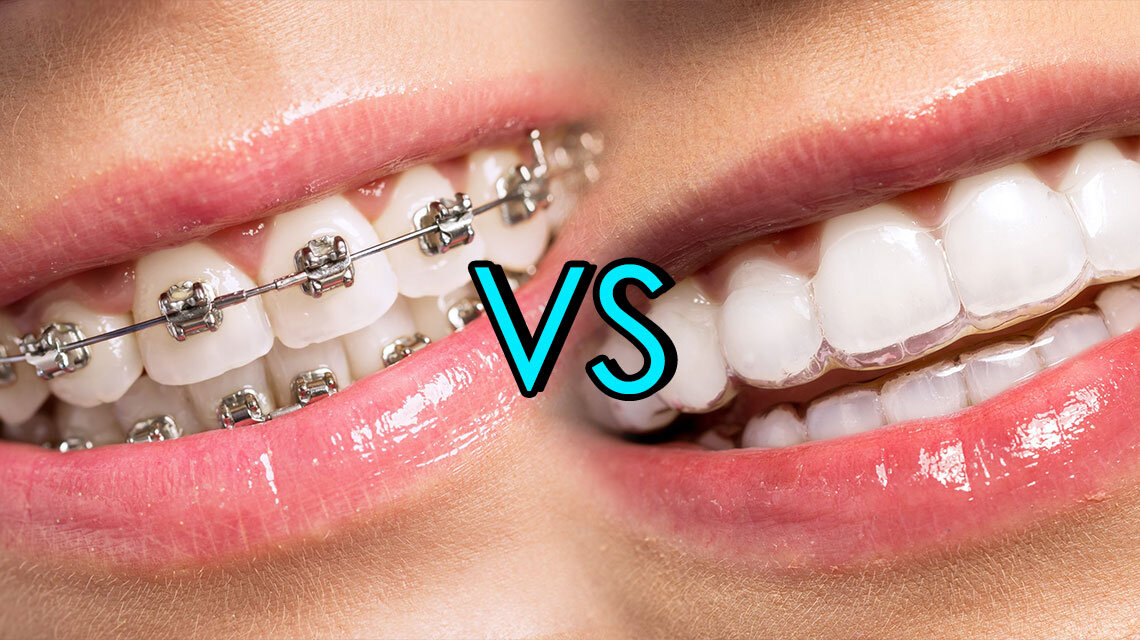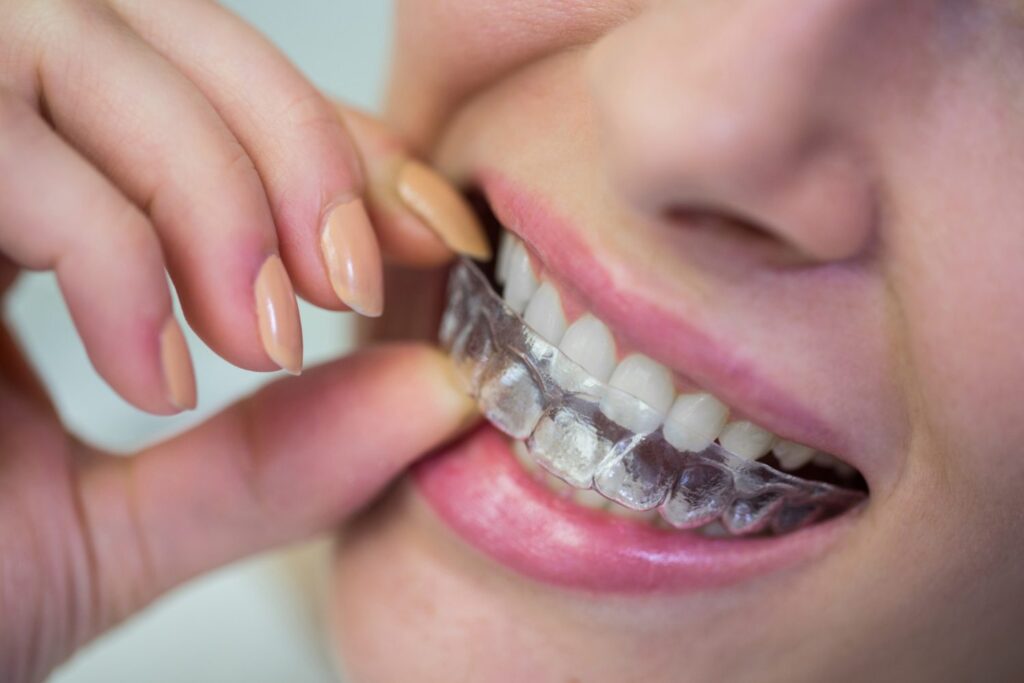Invisalign vs. Traditional Braces: Which Alternative Is Right for You?
When thinking about orthodontic therapy, the option in between Invisalign and traditional dental braces provides a number of crucial elements that warrant cautious examination. Invisalign provides a discreet alternative with detachable aligners, while standard dental braces supply a much more visible yet efficient option for severe misalignment. Each choice includes distinct benefits and drawbacks associated with visual appeals, comfort, treatment period, and cost. Recognizing these subtleties is vital for making an informed decision that straightens with your personal preferences and way of life. The inquiry remains: which alternative will best meet your orthodontic requirements and assumptions?
Overview of Therapy Alternatives

On the other hand, conventional dental braces include steel brackets and cables that are adhered to the teeth. This approach applies continual pressure over time to attain positioning. While reliable for complicated orthodontic concerns, standard braces need regular visits for adjustments and can position obstacles in preserving dental hygiene because of the trouble of cleaning up about wires and braces.
Both alternatives have their merits, and the choice frequently hinges on certain oral problems, lifestyle preferences, and patient compliance. Inevitably, consulting an orthodontic expert is critical for establishing the most appropriate treatment strategy customized to individual requirements. Understanding the subtleties of each option can substantially influence the overall success of orthodontic therapy.
Aesthetic Considerations
A substantial aspect influencing the selection between Invisalign and conventional braces is the visual appeal each therapy uses. Invisalign aligners are crafted from clear plastic, making them virtually unnoticeable when used.
In contrast, standard dental braces contain metal braces and cables, which can be more noticeable. While advancements in orthodontic modern technology have brought about the development of smaller brackets and tinted elastics, standard dental braces still preserve an even more obvious profile. For some individuals, the exposure of dental braces might deter them from seeking necessary therapy.
Ultimately, the choice in between Invisalign and typical braces might rest on personal preferences regarding appearances. Clients that prioritize discretion often lean towards Invisalign, while those who are much less concerned regarding presence may choose standard dental braces. Recognizing the aesthetic ramifications of each alternative is essential for making a notified decision that lines up with one's way of life and preferences.
Comfort and Convenience

In regards to ease, Invisalign aligners are detachable, allowing individuals to enjoy their favorite foods without restriction and keep ideal oral hygiene. Cleaning and flossing are streamlined, as the aligners can be gotten during these regimens, whereas typical dental braces call for mindful steering around cords and braces.
Additionally, Invisalign's modern system permits fewer orthodontic gos to. Patients normally receive several collections of aligners simultaneously, which can simplify the treatment process and decrease time spent in the orthodontist's chair. On the other hand, conventional braces demand routine modifications, websites making them less convenient for those with active timetables. Invisalign. On the whole, the convenience and comfort of Invisalign make it an enticing selection for numerous individuals seeking orthodontic treatment.
Therapy Period and Efficiency
While both Invisalign and standard braces are effective in remedying oral misalignments, the duration of treatment can vary considerably between both options. Commonly, Invisalign therapy can take anywhere from 12 to 18 months, relying on the intricacy of the situation. The clear aligners work by gradually changing teeth right into their preferred placements, and normal follow-ups with an orthodontist help make certain development stays on course.
On the other hand, conventional braces often require a longer commitment, usually ranging from 18 months to three years. This is due to their fixed nature and making use of wires and brackets, which can be much more effective for complicated instances and severe misalignments (Invisalign). The treatment effectiveness of conventional braces is well-documented, as they enable accurate modifications and higher control over tooth movement
Ultimately, the option between Invisalign and conventional braces might depend upon both the expected treatment duration and the specific oral concerns available. Consulting with an orthodontist is critical, as they can give customized suggestions based on individual needs, guaranteeing the chosen method aligns with desired end results and durations.
Cost Comparison and Insurance Choices
Price plays a significant role in the decision-making process for individuals taking into consideration orthodontic treatment, whether choosing Invisalign or standard dental braces. On standard, the expense of Invisalign varieties from $3,000 to $8,000, while standard braces usually cost between $2,000 and $6,000. Factors influencing these prices consist of the complexity of the case, the period of therapy, and geographical area.
Insurance policy insurance coverage can home dramatically affect out-of-pocket costs. Numerous dental insurance policy plans give partial protection for orthodontic treatments, yet the specifics can differ widely. It is critical for clients to review their insurance plans to establish the level of protection for either alternative. Generally, typical braces may be a lot more frequently covered by insurance coverage strategies compared to Invisalign, which some insurance firms categorize as a cosmetic treatment.
Furthermore, numerous orthodontic practices provide versatile settlement plans, making both treatment alternatives more easily accessible. People should ask about potential financing choices and price cuts for in advance settlements. Evaluating the total expense, consisting of insurance policy benefits and payment plans, is vital for making a notified decision that aligns with both aesthetic preferences and budget plan considerations.

Final Thought
In recap, the selection in between Invisalign and standard dental braces hinges on several elements, including visual choices, convenience, treatment duration, and cost. Invisalign offers a very discreet, detachable choice that assists in dental hygiene and dietary versatility, while conventional braces might be preferable for complicated dental concerns and usually come with a lower price factor. Eventually, examination with an orthodontist is important to evaluate individual circumstances and determine one of the most proper therapy option for achieving optimum oral positioning.
When thinking about orthodontic treatment, the choice between Invisalign and conventional braces presents a number of essential elements that warrant careful evaluation.Comparing Invisalign and conventional braces exposes distinctive treatment alternatives for orthodontic correction.While both Invisalign and traditional dental braces are efficient in fixing dental imbalances, the period of treatment can differ substantially between the 2 choices.Cost plays a significant function in the decision-making Find Out More process for people thinking about orthodontic treatment, whether deciding for Invisalign or standard braces.In recap, the option between Invisalign and traditional dental braces pivots on several elements, including visual preferences, convenience, treatment duration, and price.
Comments on “Frequently Asked Questions Concerning Invisalign: Everything You Required to Know”